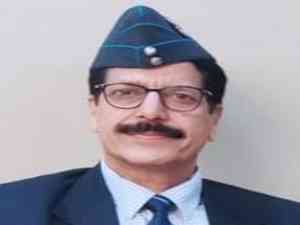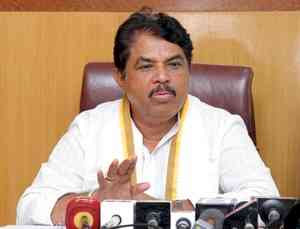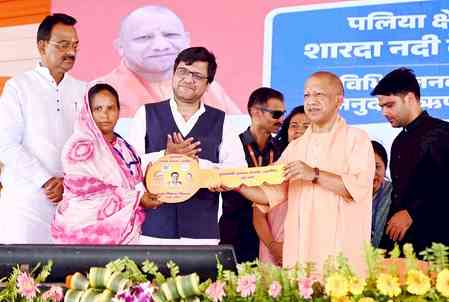25th year of Kargil Vijay Diwas: 'Operation Safed Sagar' proved 'Airpower is decisive and non-escalatory'
The Indian Air Force (IAF)'s exceptional professionalism was on full display, deploying aerospace power at the highest known height in the world for the operations named 'Operation Safed Sagar'. The IAF aircraft operated at altitudes over 20,000 feet, a feat not attempted before by any Air Force of the World, successfully surmounting the difficulties posed by extreme elevation and inclement weather conditions.

Gp Capt Dr. DK Pandey
New Delhi, July 25: The Indian Air Force (IAF)'s exceptional professionalism was on full display, deploying aerospace power at the highest known height in the world for the operations named 'Operation Safed Sagar'. The IAF aircraft operated at altitudes over 20,000 feet, a feat not attempted before by any Air Force of the World, successfully surmounting the difficulties posed by extreme elevation and inclement weather conditions.
The rapid technological innovations and modifications proved to be highly advantageous to emerge victorious in this conflict, which took place at the highest battleground in the globe.
The Beginning
Pakistan code name for Kargil War was 'Operation Koh-e-Paima', which was approved on January 16, 1999, by the Pakistani COAS Op Koh Paima, less than five weeks before the two prime ministers signed the momentous Lahore Declaration on February 22, 1999.
The Pakistani Army initiated the occupation of territory in the Kargil region shortly afterwards.
On May 3, 1999, the Indian Army discovered that the Pakistanis were present on Indian territory. The infiltration and combat occurred in ridges that overlook the road connecting Srinagar and Leh.
The military outposts situated on the elevated areas above the roadway typically had altitudes of around 5,000m (16,000 ft), with a few risings as high as 5,485m (18,000 ft).
The Indian Air Force (IAF) received its initial request for air support on May 11, 1999, specifically for the helicopters.
Subsequently, on May 25, the Cabinet Committee on Security (CCS) granted permission to the IAF to launch offensive operations against the infiltrators while ensuring they do not breach the Line of Control (LoC).
Air Operations
Kargil war was a conflict that underscored the need for a robust and responsive defence strategy. Chief of Defence Staff General Anil Chauhan, in an event in New Delhi on July 18, 2024 to mark 25 years of Kargil Vijay Diwas, said: "The Kargil conflict highlighted the significance of maintaining vigilance and preparedness for safeguarding our borders. It also emphasised the importance of public and international diplomacy, a strategy which was used effectively to maintain the neutrality of inimical nations and gain global support."
The Indian Air Force's operations during the Kargil conflict are a prime illustration of operational preparation, intelligence collection, and diplomatic initiatives while encountering numerous impediments.
Intelligence, Surveillance, and Reconnaissance (ISR) capabilities were limited, affecting target identification and battle damage assessment. The reconnaissance mission by IAF's Canberra aircraft played a crucial role in the Kargil conflict, detecting the level and limits of Pakistani intrusions and providing vital intelligence.
This early detection was instrumental in the IAF's subsequent operations. The IAF's fighter jets, including MiG-21s, MiG-27s, and Jaguars, then provided close air support to ground troops and attacked enemy positions.
The Mirage-2000 aircraft carried out precision strikes using laser-guided bombs, targeting enemy bunkers and supply depots.
Total of 7,631 sorties were flown -- then the IAF had 42 fighter sqns in 1999 but only 90 aircraft were deployed, 45 in the valley and 45 out of the valley.
Fighter flew 1,730 sorties (Day ops sorties:1,643 & Night sortie:87), Helicopter: 2,474, Transport ac: 3,427 (Max).
During the conflict, the IAF's role in transporting over 20,000 troops, 1,500 tonnes of equipment, and 1,200 tonnes of ammunition was a testament to their logistical capabilities and the scale of their operations.
Full Force Braveheart Operations: IAF aircraft conducted night operations using available technology such as night vision goggles and navigation systems, demonstrating their adaptability and commitment to mission success.
IAF transport aircraft and helicopters ferried troops, equipment, spares and other support supplies to forward bases, maintaining a steady supply chain.
IAF helicopters, including Mi-17s and Mi-35s, conducted daring rescue missions, evacuating wounded soldiers from forward areas.
Coordination with Army: The IAF's close coordination with the Indian Army, providing real-time intelligence and strike support, was a testament to the strength and unity of the Indian defence forces, reassuring the nation of their combined capabilities.
Effective coordination between the IAF and the Indian Army played a vital role in accurately striking enemy locations during the Kargil War.
Decisive Operations: High altitude posed unique operational difficulties in targeting the enemy. Professionally conducted IAF airstrikes disrupted Pakistani troop movement and logistical support, making it difficult for them to reinforce their positions or retreat effectively.
The swift technical modifications and on-the-job training held IAF in good stead in its employment of air power to win this war fought at the highest battlefield of the world.
Overall, IAF flew around 5000 strike missions, 350 reconnaissance/ ELINT missions, and around 800 escort flights. The IAF also flew over 2,000 helicopter sorties towards casualty evacuations and air transport operations.
The successful air strikes on Tiger Hill, MunthoThalo, and Toling changed the direction of the operations towards India.
Limitations Encountered: In the report compiled by the Kargil Review Committee (KRC), the many constraints that were associated with airpower operations during the Kargil War were brought to light.
The following were the limitations that were encountered during Kargil operations.
(a) Weather Conditions: Harsh weather, including dense fog, clouds, and gusty winds, hindered air operations.
(b) High-Altitude Challenges: Operating at extreme heights posed significant challenges for aircraft and crew.
(c) Logistical Challenges: Transporting fuel, ammunition, and spare parts to forward bases was a significant logistical challenge.
(d) Limited ISR and Air Defence Capabilities: IAF's air defence systems had limited capabilities against Pakistani missiles and aircraft.
It is testament to the exceptional skills of the IAF and, especially, to their resiliency that they were able to successfully overcome such difficult conditions, which inspired everyone who observed their remarkable efforts.
The IAF was able to achieve significant success in the Kargil War by adapting to new circumstances and utilising its strengths.
Lessons Learnt
The Kargil Conflict led to significant changes in the IAF airpower operations, including:
(a) Modernised IAF: The Indian Air Force (IAF) has included advanced fighter aircraft, including the Rafale, Tejas Mk1A, and MI-17 V, to replace its outdated fleet of MiG series jets, thereby modernising its aircraft fleet.
(b) Enhanced Intelligence, Surveillance, and Reconnaissance (ISR) Capabilities: The ISR capabilities have been enhance capabilities to identify targets and assess combat damage.
(c) Network-Centric Operations (NCO) capacity: The establishment of a network-centric warfare capacity has allowed for the improved situational awareness, leading to timely decision-making.
(d) Advanced Training Incentive: All pilots get comprehensive training for both day and night missions. Regular joint exercises are held to strengthen operational readiness and interoperability.
(e) Logistics and Maintenance Upgrades: Requisite enhancements have been implemented in the logistics supply chain to guarantee accessibility in all types of terrain for all support and maintenance infrastructure.
Conclusion
Kargil Vijay Diwas is celebrated every year on July 26 to commemorate India's victory over Pakistan in the Kargil War of 1999. The IAF's airpower operations played a crucial role in the Indian military's victory in the Kargil War.
Without a shadow of a doubt, the efficient utilisation of air power has prevented more losses and significantly shortened the period of time during which our Army has made such significant advancements on the ground.
(Dr. DK Pandey was the Group Captain in IAF. He undertook AD operations in the Western, J&K and NE sectors. He has commanded six Air Defence (C&R) Units. He was Director Air Staff Inspections and retired as Director, Joint Control and Analysis Centre)


 IANS
IANS 










